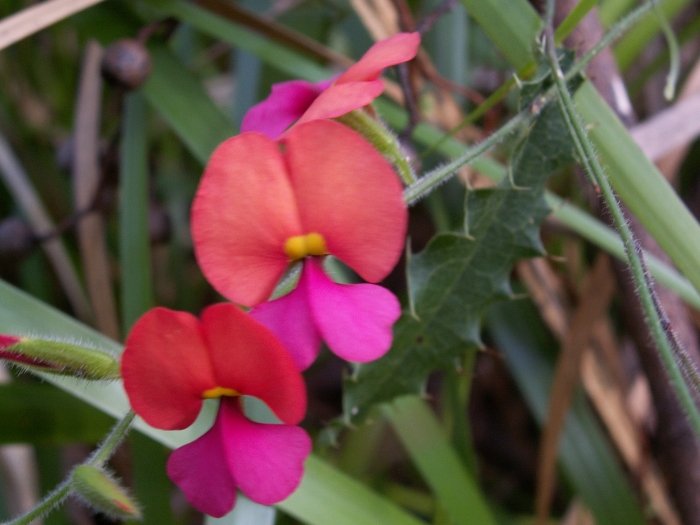Holly Flame Pea
(Chorizema ilicifolium)
Holly Flame Pea (Chorizema ilicifolium)
/
/

Geoffrey Derrin
CC BY-SA 4.0
Image By:
Geoffrey Derrin
Recorded By:
Copyright:
CC BY-SA 4.0
Copyright Notice:
Photo by: Geoffrey Derrin | License Type: CC BY-SA 4.0 | License URL: https://creativecommons.org/licenses/by-sa/4.0 | Uploader: Gderrin | Publisher: Wikimedia Commons | Title: Chorizema_ilicifolium_flowers.JPG | Notes: User created page with UploadWizard |






























Estimated Native Range
Summary
Chorizema ilicifolium, commonly known as Holly Flame Pea, is an evergreen shrub native to the gravelly and sandy soils of open eucalyptus woodlands and heathlands in Southwest Australia. It typically grows to a height of 1-3 feet (0.3-0.9 meters) and a width of up to 2 feet (0.6 meters). The plant has a compact, bushy habit with small, holly-like leaves that are prickly to the touch. From late winter to spring, it produces striking pea-shaped flowers with vibrant red and orange hues that are highly ornamental and attract pollinators.
Holly Flame Pea is valued for its drought tolerance and vibrant flowers, making it a suitable choice for rockeries, native gardens, and as a container plant. It thrives in well-drained, acidic to neutral soils and benefits from a position that offers protection from harsh afternoon sun. While it requires minimal water once established, it does appreciate occasional watering during prolonged dry periods. It is not widely known for having significant disease or pest problems, but it can be sensitive to Phytophthora root rot in poorly drained soils. To maintain a neat appearance and promote bushier growth, light pruning after flowering is recommended.CC BY-SA 4.0
Holly Flame Pea is valued for its drought tolerance and vibrant flowers, making it a suitable choice for rockeries, native gardens, and as a container plant. It thrives in well-drained, acidic to neutral soils and benefits from a position that offers protection from harsh afternoon sun. While it requires minimal water once established, it does appreciate occasional watering during prolonged dry periods. It is not widely known for having significant disease or pest problems, but it can be sensitive to Phytophthora root rot in poorly drained soils. To maintain a neat appearance and promote bushier growth, light pruning after flowering is recommended.CC BY-SA 4.0
Plant Description
- Plant Type: Shrub
- Height: 1-3 feet
- Width: 1-2 feet
- Growth Rate: Moderate
- Flower Color: Red, Orange
- Flowering Season: Winter, Spring
- Leaf Retention: Evergreen
Growth Requirements
- Sun: Part Shade
- Water: Low
- Drainage: Medium
Common Uses
Drought Tolerant, Low Maintenance, Showy Flowers
Natural Habitat
Open eucalyptus woodlands and heathlands in Southwest Australia
Other Names
Common Names:
Scientific Names: , Chorizema ilicifolium, Chorizema triangulare, Chorizema denticulatum, Chorizema ilicifolium var. pandolfinii,
GBIF Accepted Name: Chorizema ilicifolium Labill.